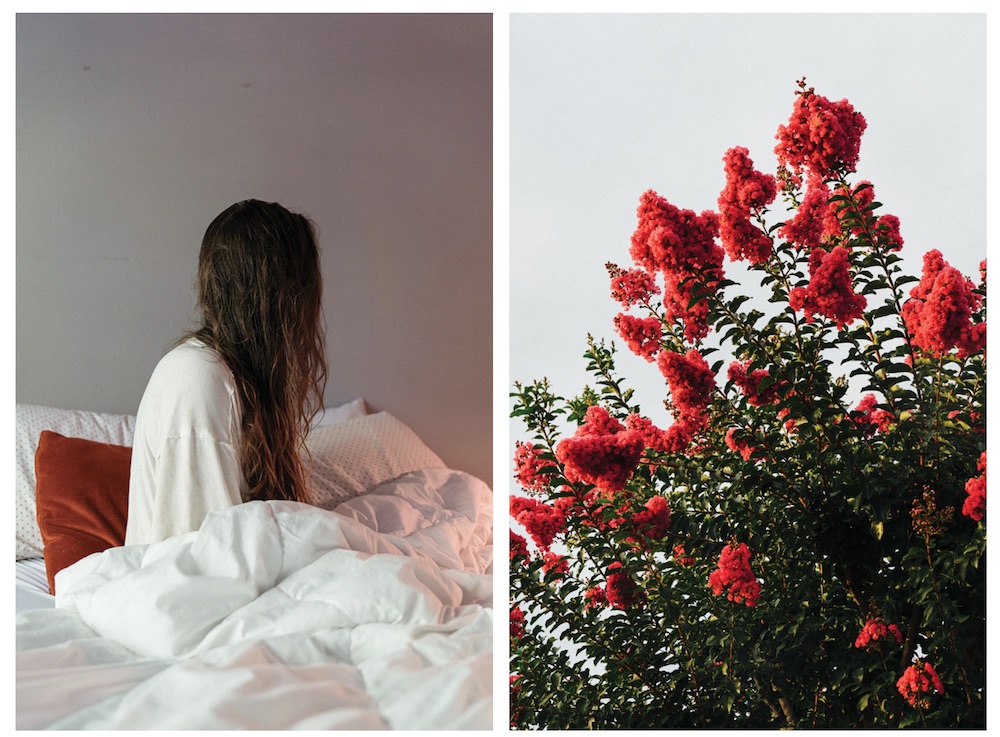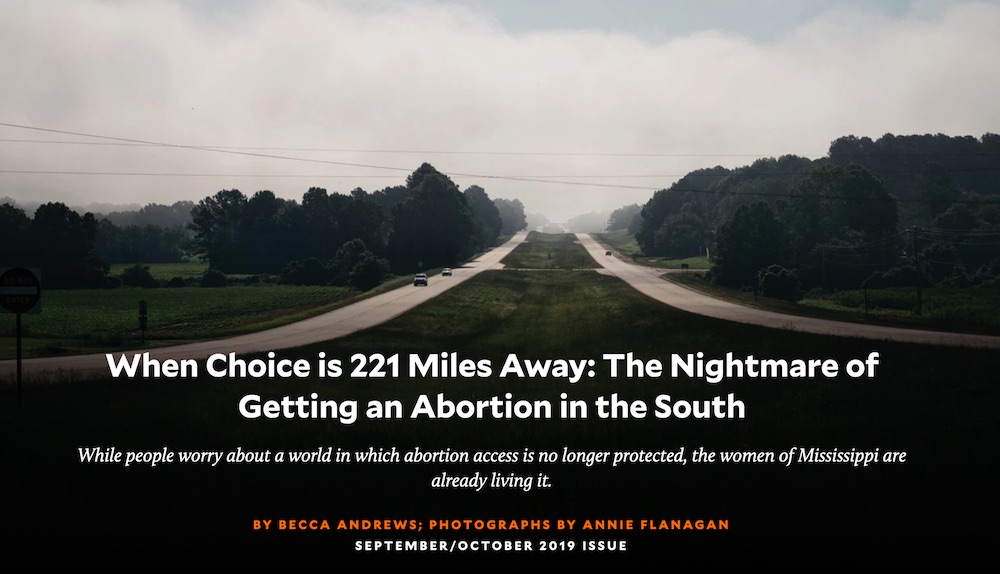How Mother Jones reported “The Nightmare of Getting an Abortion in the South”
It’s no secret that abortion laws have been a point of contention in the United States over the past few years, with several states recently introducing new laws that make it more difficult for women to access reproductive healthcare.
To take a look at how these regulations impact real people, Becca Andrews, assistant news editor at Mother Jones, followed a young woman from Mississippi as she traveled to Little Rock, Arkansas to get an abortion. In the resulting story, titled “When Choice is 221 Miles Away: The Nightmare of Getting an Abortion in the South,” Andrews details how “Kate” was first turned away from the clinic and then, just a week later, made the cross-state journey all over again.
Storybench sat down with Andrews to understand how the story came about and why she decided to follow “Kate” on this tiring journey.
This story was part of Mother Jones’ “Post-Roe issue.” Can you tell me a little more about the origins of this issue?
Like a lot of publications, after the bigger abortion bans started coming down, we started to really take a look at our reproductive rights coverage and we felt like it was important to highlight it in this moment. It’s sort of a coincidence that my feature landed in this, because it’s been in the works for a really long time, and the timing just worked out.
Where did you get the idea for this story?
I’ve been interested in Mississippi Reproductive Freedom Fund for a really long time now. I’m from West Tennessee and Northern Mississippi, so I’m really familiar with the South and a lot of my reporting takes place in the South, and I’ve been aware of Laurie [Bertram Roberts, executive director of MRFF]’s work for a long time. I called her soon after the Kavanaugh hearings just to talk about abortion access in the South, and I told her that I’d really like to do a ride-along with them and with a patient at some point. For the next year I would check in with her periodically to catch up and see what was going on. I knew it was really important to build trust with her before they would feel comfortable with me doing a ride-along. Something she was concerned about, too, was the power dynamic. They’re providing money and access to abortion care, and they didn’t want any of their patients to feel pressured into allowing me to come along on the ride.
What was your goal in telling Kate’s story?
I really wanted to highlight the journey, and what it wakes to get an abortion in the South for a normal person, someone who doesn’t have a ton of money, who doesn’t have a ton of, resources. Laurie put it really well in my story where she said that there are barriers at every turn before you even start having sex as a young woman in the South, and I really wanted the opportunity to lay that out in a narrative. Honestly, I was very taken with Laurie as a character from the first I talked to her. She is extremely charismatic, she is very charming, she is very eloquent, and I just knew that she would really come to life on the page.
What was the reporting of this story like?
It was sort of a hectic turnaround. I got the text message from Laurie that Kate had agreed to talk to me on a Thursday evening at 4 p.m. or so, and she asked me if I could be in Little Rock tomorrow morning, so I went home and packed a bag and booked a plane ticket, and was out the door before the sun the next morning. There’s so much adrenaline in a reporting trip like that.
I think as a reporter I’m at my best in intimate one on one scenarios. We caught up maybe two hours after I got there and I knew it was going to be important again to gain her trust and let her get to know me and get comfortable with me before we started any real interviewing, so I just hung out with her and Sarah [Roberts] and Aolani [Jefferson, Laurie Bertram Roberts’ daughters who accompanied Kate] by the pool for an hour before we actually went up to my room to do a long, formal interview. In a lot of ways it really helped that I am from the South. These are just like the people that I grew up with, so it’s very easy for me to relate to them and connect with them because of that background.
Did Kate open up to you easily?
Pretty quickly it was one of those tough things because she was clearly very upset and very frustrated that she’d been turned away, and that’s part of why I spent more time with her before we started the actual interview, because I wanted her to feel like she had her feet under her before we started into it. I think it’s very important to be more careful and a little more delicate with everyday people. She’s not a politician or public figure; she has no experience with the media. It was important to me to spell everything out for her first.
Was there anything you learned that surprised you when you were reporting on this story?
I’m from the South, but I live in California now, in the Bay Area. It’s a place with a lot of privilege and very progressive politics, and in some ways it feels very insulated, so it always takes me a minute to readjust to being back on the ground in the South. It’s one thing to think about the stuff conceptually and read about it, and it’s quite another thing to be living it alongside someone else. I was also tired and sweaty and dirty in the van, and just experiencing things as she was experiencing them had a different level of power. We’ve all read stories like this before, but for me personally, it felt very profound to experience that alongside her.

The photos in this piece are really intriguing to me – they almost look more like art rather than images for journalism. Was the photographer, Annie Flanagan, involved with the whole reporting process?
We were in touch, but it was different trips. We have this really incredible photo editor, Mark Murrmann, and every time I do a piece on the South he finds me a badass photographer, which I really appreciate. [Annie and I] were just texting back and forth a lot setting up different shoots with Kate and Laurie, and because it was delicate, it was easier for me to act as intermediary.
How were the images chosen?
They read drafts of the story before they went out to shoot. Part of what the thought process was for some of the more scenery shots are, they were trying to go along the route that we took and shoot. The flowers are creek myrtles, which are everywhere in Mississippi, so when I saw that, I said that has to be in there. With Kate, there were a few photos. The one that we ended up going with, Mark felt was the most striking. [Flanagan] tried a few different approaches because we had to obscure her identity and anonymize her as best we could. She signed off on the photo.
Getting the shot of Laurie was actually v difficult because she was actually very sick. For a couple weeks we kept scheduling and rescheduling, and then the day came and it was the last chance before Annie had to leave on another shoot. Laurie was sick in bed and did not want to be shot, which was very understandable, and Annie just stayed there with her and built a rapport with her until she would let her shoot her. We have two shots that are just like the one in the magazine, and that’s all we got.
This article has an audio version as well. Is this something that Mother Jones does often? How was this story chosen for this?
We do it here and there. We started a partnership with Audm. Basically, writing a story is the last thing that I get to do on my plate. One of the main parts of my job is to translate magazine stories to web stories, so at the end of every magazine production, I send an email to Audm here are two or three of our stories that would feature well, and they produce them.
What were some of the biggest challenges in telling this story?
It was a really fast turnaround because we wanted it in this issue. It was also a time when I was traveling a lot; I literally wrote this story in all four time zones, lots of hotel rooms and planes and friends’ living rooms. In a way, it was really fun doing it in a lot of ways, but that was really difficult.
The other thing is that Buzzfeed was able to piggyback off of my access to get the ride-along with Kate when she actually got the abortion, so they scooped me. I had asked multiple times if they were talking to other reporters, but didn’t know they had gotten a ride along. They got theirs up there fair and square, and I wanted to take my time writing it in a clear magazine style, so it all worked out in the end. It is a thing that happens, and I think we all feel so much pressure and shame around when it happens, but it’s just unavoidable.





